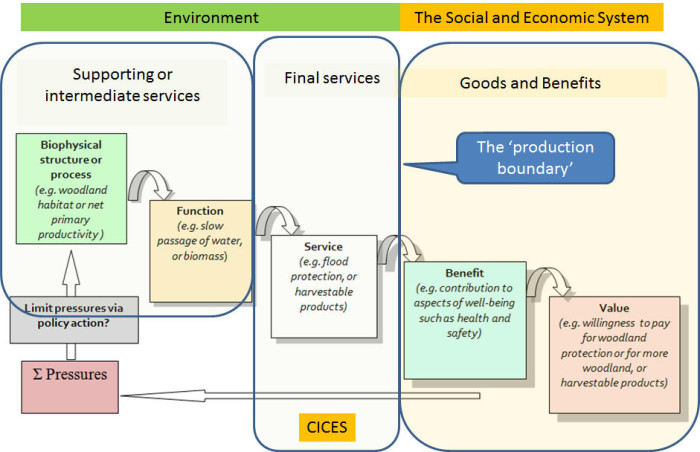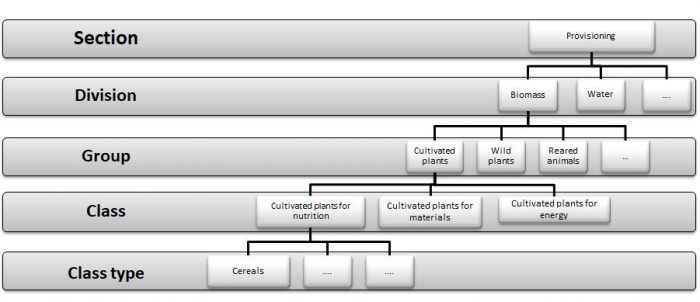The revision for V5.2 largely preserves the structure and concepts embodied in the earlier version but clarifies definitions and the guidance needed to apply them; a small number of additional classes have been added to cover gaps or deal with overlaps between the different classes of ecosystem services. The cascade model shown below provides the conceptual framework underpinning CICES; it is described in more detail in the revised guidance document that is available.

CICES seeks to classify what are known as ‘final ecosystem services’. These are defined as the contributions that ecosystems (i.e. living systems) make to human well-being. They are ‘final’ in that they are the outputs of ecosystems (whether natural, semi-natural or highly modified) that most directly affect the well-being of people.
Thus CICES recognises that provisioning, regulating and cultural services as the main categories of biophysical ecosystem outputs, but it does not cover the so-called ‘supporting services’ originally defined in the Millennium Ecosystem Assessment. CICES regards supporting services as part of the underlying structures, process and functions that characterise ecosystems. Since they are only indirectly consumed or used, and may simultaneously facilitate many ‘final outputs’, they are best dealt with in environmental accounts and mapping in other ways.
To deal with the fact that people work at different spatial and thematic scales, CICES describes ecosystem services by means of a five-level hierarchy, where each level is progressively more detailed and specific. The scope of the classification is comprehensive, aiming to include all that can realistically be considered as an ecosystem service. The way it works can be seen in the diagram below, showing how ‘cereals’ might be classified.

To emphasise the ‘purposeful’ nature of an ecosystem service, the definition of each service is made up of two parts, one describing the biophysical output from the ecosystem (i.e. what the ecosystem does) and the other describing the contribution it makes some benefit (i.e. how that output is used or enjoyed by people). This approach can help people distinguish services from the underlying ecological structures and processes and the benefits and values that people hold for the various services.
- For example, the service ‘Wild animals (terrestrial and aquatic) for used nutrition’ would be defined as ‘non-domesticated, wild animal species and their outputs (ecological clause) […..] that can be harvested and used as a raw material for the production of food (use clause)’.
- Similarly, the service of ‘pest control’ would be ‘the reduction by biological interactions of the incidence of species (ecological clause) [……] that damage or reduce the output of food, material or energy from ecosystems, or their cultural importance, by the consumption of biomass or the spreading of disease (use clause)’.
Although the primary focus of CICES is on the way living systems (‘biodiversity’) give rise to these services, for completeness it also provides a way of classifying the abiotic or geophysical contributions that an ecosystem can make. The geophysical classification sits alongside the biophysical one and ensures that the classification is as comprehensive as possible. However, CICES does recognise that many ecosystem service outputs are a combination of both biotic and abiotic factors, and views these as now being covered in the revised biophysical part of the classification.
Although the majority of the classes included in V5.1 carry over to V5.2, their ordering and coding has been modified in the new version to enable users to more easily aggregate Classes for reporting purposes.
The full set of CICES classes can be found on the spreadsheet that can be downloaded here. The spreadsheet provides a cross walk to earlier versions of CICES and other systems used to classify ecosystem services.